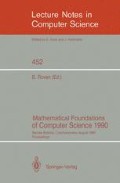Abstract
An N-resolution proof is a resolution proof in which the resolution rule is restricted: One clause to which it is applied must only consist of negative literals. N-resolution is complete. ([8], p. 109,
Preview
Unable to display preview. Download preview PDF.
Literature
M. Ajtai, The complexity of the propositional pigeonhole principle, Proc. of the IEEE FOCS (1988).
S. R. Buss and G. Turán, Resolution proofs of generalized pigeonhole principles, Theoret. Comp. Sci. 62 (1988) 311–317.
V. Chvátal and E. Szemeredi, Many hard examples for resolution, J. Assoc. Comput. Mach. 35(4) (1988) 759–768.
A. Goerdt, Davis Putnam resolution versus unrestricted resolution, Journal of Discrete Applied Mathematics, Special issue on proof lengths, accepted for publication.
A. Goerdt, Regular resolution versus unrestricted resolution, Technical report, Univ. of Duisburg, submitted.
A. Haken, The intractability of resolution, Theoret. Comput. Sci. 39 (1985) 297–308.
J. A. Robinson, Automatic deduction with hyper-resolution, (1965), in [11] vol. 1, 416–423.
U. Schöning, Logik für Informatiker, BI-Taschenbuch, Reihe Informatik 56 (Bibliographisches Institut, Mannheim, 1987).
M. E. Stickel, An introduction to automated deduction, Fundamentals of artificial intelligence (Bibel, Jorrand eds.), Lect. Notes of Comp. Sci. 132 (Springer Verlag, Berlin, 1986) 75–137.
M. E. Stickel, A PROLOG technology theorem prover: Implementation by an extended PROLOG compiler, J. of Automated Reasoning 4 (1988) 353–380.
J. Siekmann, G. Wrightson (eds.), Automation of reasoning — classical papers on computational logic, vol.1 and 2, Springer (1983).
G. A. Wilson, C. Minker, Resolution, refinements and search strategies: A comparative study, IEEE Transactions on Computers C-25 (1976).
A. Urquhart,Hard examples for resolution, J. Assoc. Comput. March 34 (1987), 209–219.
Author information
Authors and Affiliations
Editor information
Rights and permissions
Copyright information
© 1990 Springer-Verlag Berlin Heidelberg
About this paper
Cite this paper
Goerdt, A. (1990). Unrestricted resolution versus N-resolution. In: Rovan, B. (eds) Mathematical Foundations of Computer Science 1990. MFCS 1990. Lecture Notes in Computer Science, vol 452. Springer, Berlin, Heidelberg. https://doi.org/10.1007/BFb0029622
Download citation
DOI: https://doi.org/10.1007/BFb0029622
Published:
Publisher Name: Springer, Berlin, Heidelberg
Print ISBN: 978-3-540-52953-8
Online ISBN: 978-3-540-47185-1
eBook Packages: Springer Book Archive

